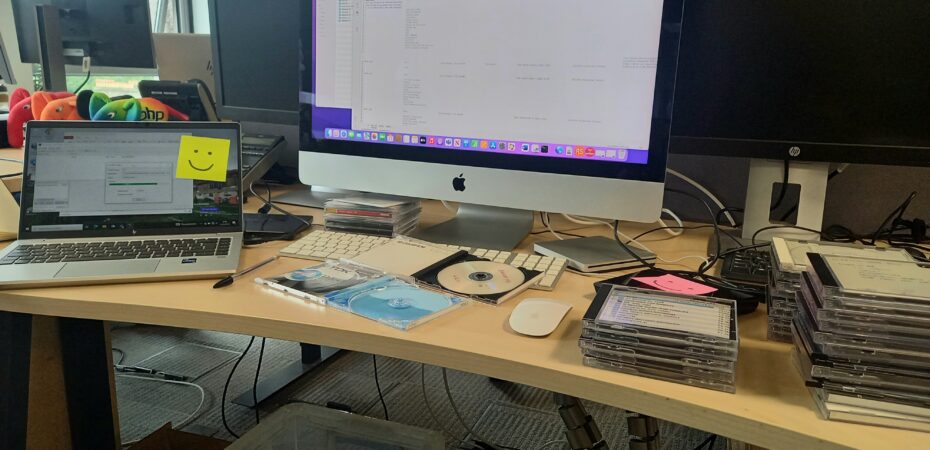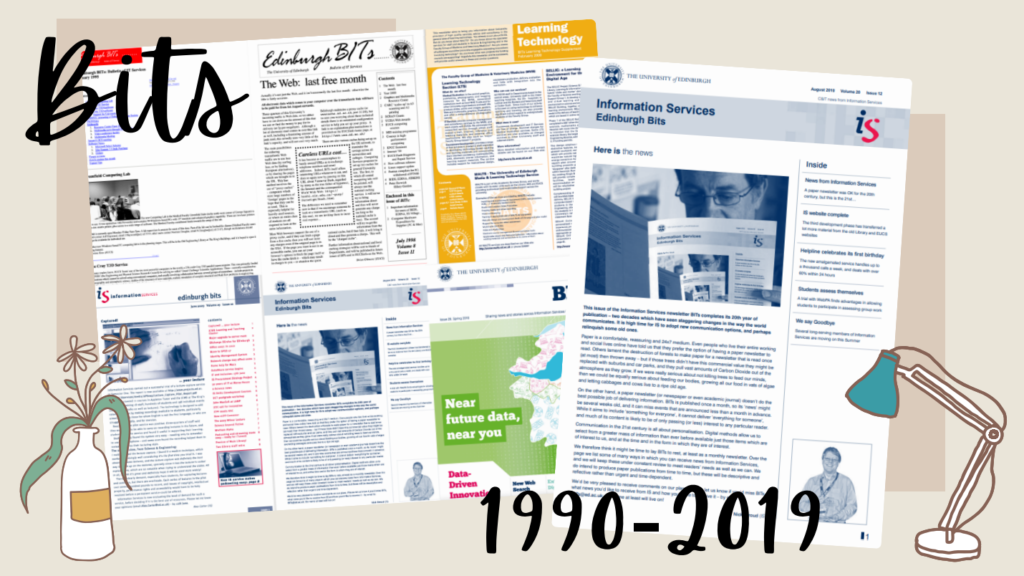Re-blogged from Information Services Group: Student Employee Blog
Programme of Study and Year: 1st Year German
Intern Position: Digital Preservation Intern
Hobbies: Piano, a sprinkling of violin (and soon flute!), running and tea

“Don’t assume you’ll be able to read your email if you go to the States” and other things I’ve learnt from working with the BITS Magazine this summer.
It’s almost the end of my internship and yet again I find myself staring at the castle… although this time in order to induce some self-reflection, because over the course of my internship, I think I’ve learnt rather a lot.
For those of you who are unaware, or haven’t read my other blogs (now would be a great opportunity), I’ve been working over the summer with Sonia Virdi (Graphic Design Manager) and Sara Day Thomson (Digital Archivist) to digitally preserve editions of the BITS Magazine.

Surprise surprise, BITS is an acronym and actually stands for the Bulletin of IT Services, something I didn’t know until embarrassingly late, but I hope I can be forgiven since I have only been working in IT for a few months. BITS started in 1990 as a monthly publication reporting mainly on news and developments in Information Technology at the University, before it became a triannual Magazine from 2011-2019. BITS has been through several design iterations, the first of which were perhaps not the nicest to look at, but nowhere near as much an eyesore as 40GS or Gordon Aikman. In any case, thanks to Nick Stroud, the BITS Team, and the Graphic Design Team, we can look back at the evolution of the BITS covers and designs, as well as the work achieved by Information Services over the years with much pride.

Armed with a giant box of discs, two disc readers, a mac, two laptops and a magic mouse, I embarked on the task of collating together as many original BITS files as possible. I must add that the glamour of having a desk covered in shiny CDs and fancy equipment didn’t last for long as I proceeded to lose all dignity by manually downloading 200 PDFs. On the other hand, floods, a bunch of corrupt discs and lost legacy document stores did help put things in perspective. I realised the importance of my work as a Digital Archivist, and just how lucky we’ve been to be able to extract as many files as we did. After all, 230 editions covering 26 years of ISG history isn’t too bad.
I’m so proud of what I’ve achieved this summer, especially the amount of knowledge and new skills I’ve picked up. I distinctly remember being asked in the interview for this job if I could name any file types and the resounding silence thereafter, potentially more embarrassing than not knowing what BITS stands for. As I’ve flourished into a Digipres Pro, I’ve also had my moments of *imagined* standing up, cheering and setting off a few fireworks from Castlehill. The feeling of discovering hundreds of editions of BITS in a lost legacy document store as a result of trying to stalk Nick Stroud on the internet, and then beating all the Digital Archivists in Scotland to opening a rare file type is indescribable.
BITS itself has also been a continuous source of inspiration, advice and entertainment – the voice of Nick Stroud has been guiding me through my last few weeks, which’ve been tough given I’ve practically been living in the 1990s. I’ve journeyed through the invention of the World Wide Web, Electronic Mail and even Y2K, one I don’t think my parents were ever expecting to hear again.
BITS is undoubtably an important historical document for the University. It details the University’s role in innovating and implementing the latest technologies for the benefit of the local and academic community since the 1990s. Being an internal publication, BITS provides a unique insight into the inner workings of the University through the lens of Information and Learning Technology; day-to-day challenges and structural changes, reflecting the ever-evolving relationship between the University itself and IT Services in its design as much as its content. As Information Services has expanded to incorporate previously separate areas of work, so did the remit of BITS, bringing together stories from across the organisation and shining a light on the diversity of the people and the services they provided at Information Services. BITS is a reminder too, as we face yet another turning point of technological change, to remember how far we have come, but not to forget that it is our responsibility to ensure that we harness technologies to better the communities we serve.
Thank you so much to Sara and Sonia for supporting me over the course of my internship. It has been both a pleasure and a privilege to work with BITS this summer, and I look forward to carrying on my work throughout the next academic year.

Excerpt from BITS February 1996
